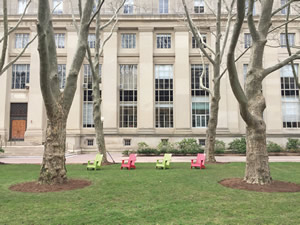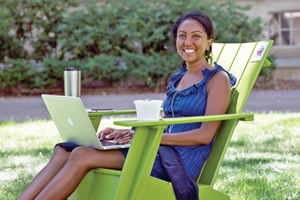Planning for Movable Furniture

PHOTO COURTESY OF TODD ROBINSON/MIT
As the landscape architects in the Office of Campus Planning, my colleagues and I try to increase the use of the Massachusetts Institute of Technology’s open spaces by incorporating movable furniture onto our Cambridge, MA, campus.
However, project sponsors at institutions can be wary to include them in the design; along with the cost of the materials comes the supposition that movable furniture will “walk away” from the intended locations.
The Starting Point
When I started working at MIT in 2015, the movable furniture count in open spaces totaled six chairs and two tables; our team wanted to increase that number. Our big break came in 2016; a chancellor-sponsored initiative called the MIT MindHandHeart Innovation Fund held a competition seeking creative ideas to promote community and mental well-being on campus. A competition entry from an associate professor in the Political Science department suggested that some colorful chairs be incorporated into public locations to promote connectedness. This idea won the grant—a substantial one, at that—and approval from leadership to move forward. Unsure of how to proceed, MindHandHeart reached out to the director of Campus Planning for assistance, and the project landed on the desks of our landscape architecture team.
Our initial experiment with movable furniture showed that it was well used by students, faculty, and staff. However, we felt the equipment was smaller and lighter than we’d hoped for. Also, over time we also noticed the material was taking a beating, becoming slightly rickety after a season or two, particularly when we attempted to overwinter them.
Refining the Plan

PHOTO © MAISIE O’BRIEN
FRIENDLY FURNITURE: Students enjoy sitting in the colorful Adirondack chairs in MIT’s Eastman Court, where they can relax and catch up email, listen to the birds, chat with a friend, or even glimpse one of the rabbits that have proliferated across the campus.
For this next project, we knew what changes we wanted to make and we hit the ground running, studying multiple furniture types and more durable materials. We also considered lounge chairs versus standard seating, and chair-and-table combinations. We researched various campus locations, and deliberated between internal pockets of campus versus locations along campus arteries. If this was going to work we realized that we needed a highly visible space to not only make it successful but also to keep the furniture in place. Similar projects at neighboring schools had seen attrition, resulting in a few universities instituting an “amnesty day,” where staff turned a blind eye as furnishings made their way back to their original locations.
While we narrowed down sites and furnishing types, we also began to roadshow the idea to the necessary institutional departments. We contacted Grounds to discuss how these would affect standard site maintenance such as mowing, and sought their help with winter storage. We met with campus police to discuss potential locations. We contacted building managers for approvals of particular locations. Each group had suggestions that we used to make adjustments and improve the overall project.
The Installation
The final furnishings came in the form of 12 colorful Adirondack chairs made of recycled materials, each weighing 50 pounds. Selecting products using recycled materials aligned well with MIT’s multiple sustainability initiatives; each chair was made of approximately 50 milk jugs. The extra weight would make it easy enough to pull chairs together at the site, but harder to lift them up and carry them away. Each chair itself is strong and well assembled, the color integrated into the soft and durable plastic, and it was roomy even for my 6'2'' frame. For a final touch, the chairs were outfitted with a sticker that labeled each of them as part of the MIT MindHandHeart initiative, meant to further deter pilfering as well as publicize the initiative.
The winning destination for the installation was Eastman Court, a picturesque open space cradled between MIT’s Main Group to the west, Building 18 designed by I.M. Pei on the east, and the Hayden Memorial Library to the south. Each building, like most of MIT, is active 24 hours a day, providing around-the-clock eyes on the area. The court’s most compelling feature, however, is the copse of 70-foot-tall London Plane trees that march through the site, branches starting at 20 feet high. While you walk the court, the green and red Adirondack chairs deliver pops of color while providing scale to the colossal trees.
In June 2017, the 12 chairs were in place in Eastman Court. Then, almost by accident, an unofficial club was formed, made up of project contributors including staff from MIT MindHandHeart, the department of Facilities, and MIT Grounds. We were known unofficially as “The Chair Counters.” By August of that summer, I learned that many of us would take special detours on campus to pass through Eastman to make sure all 12 chairs were still there. Or at least it started that way. After a while, I was more interested in watching how the chairs moved around the area, an observation echoed by other chair counters. A common question was, “Should we put chips on them to track their movements?” The chairs, as expected, were a huge success.
Organic Growth
Within months the Office of Campus Planning and MIT Mind-HandHeart were receiving calls from other departments interested in duplicating what we’d created at Eastman. We soon had more chairs on order for outdoor and interior spaces. In addition to the Adirondack chairs, our moveable furniture portfolio grew to include variably sized round pedestal tables with matching chairs, as well as some teak furniture specifically chosen for more formal campus locations. A year after the debut of the original 12 chairs in Eastman, the movable furniture count has increased to over 30 individual pieces, with more to come.
In the winter of 2017 we moved the Eastman chairs to a building atrium near MIT Medical. The building manager was eager to house them, and for a reason. At lunch people had been sitting on the atrium’s monumental central staircase, forming impromptu smallgroup spaces while eating lunch. Now people had a proper place to sit. In fact, this winter storage may have been too successful. A building occupant recently pulled me aside and said, “You’re going to have a hell of a time getting those chairs out of here and back to Eastman.”
From the perspective of this chair counter, that is a nice problem to have.
MINDHANDHEART @ MIT
MindHandHeart (MHH) is a coalition of students, faculty, and staff with fresh insights, new ideas, and diverse perspectives working collaboratively and strategically to strengthen the fabric of the MIT community.
Co-sponsored by the Office of the Chancellor and MIT Medical and led by Faculty Chair Rosalind Picard, MHH fills a strategic niche in areas shown by research to promote mental health and well-being and reduce the risk of suicide. MHH does this through four main channels:
1. An Innovation Fund seeding novel approaches to well being and mentoring passionate students as their innovative ideas develop. This is the fund that made the moveable furniture project profiled in this article possible.
2. A volunteer coalition that brings voices from across the Institute together to solve problems and develop opportunities in new ways.
3. Strategic partnerships designed to connect MHH with other culture-shaping initiatives promoting respect, health, and the community’s shared humanity.
4. And, a Department Support Project, an effort in several academic departments to share successes and coordinate enhancements in order to strengthen the welcoming and inclusive nature of MIT’s academic climates.
To learn more about MindHandHeart’s mission and impact at MIT, visit mindhandheart.mit.edu/about.
This article originally appeared in the College Planning & Management May 2018 issue of Spaces4Learning.